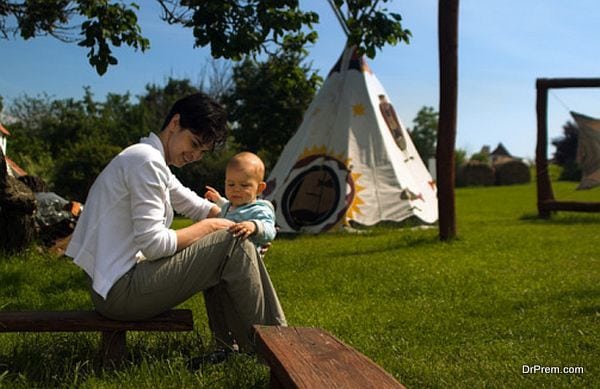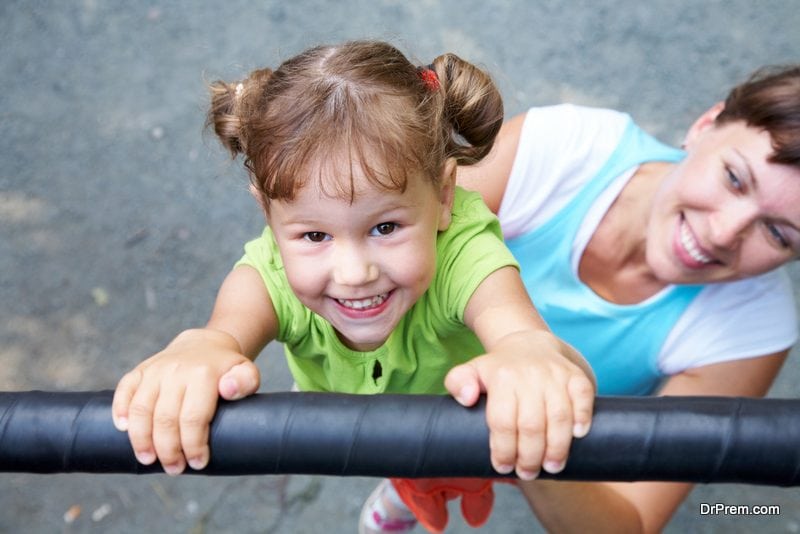Playgrounds are designed to bring joy to whoever wants to take some time on a hot summer’s day to play around and enjoy themselves. There are three different classifications of playground ages: toddler (6 – 23 months), preschool (2 – 5 years) and school age (5 – 12 years). Between them, they all have differences that set them apart from one another in terms of appropriateness for the age level.
Based on the average ability of each age group, playground designers needs to consider what is and is not appropriate to include in the playground to achieve maximum enjoyment and minimal (and hopefully zero) chance of injury. For example, you would not find monkey bars in a toddler playground and you not find preschool sized swing sets in a school-age playground This ensures that the playground contains features that allow the area to be fun but also safe for whatever age level it is designed for..
Toddlers (6 – 23 months)
 These playgrounds are designed to promote cognitive understanding and motor skills and features areas where they can move around. At this age, children can do very little else other than crawl and explore and so having space where they can move safely through tunnels and tubes and under arches or through doorways is vital towards encouraging them to make the most of their abilities.
These playgrounds are designed to promote cognitive understanding and motor skills and features areas where they can move around. At this age, children can do very little else other than crawl and explore and so having space where they can move safely through tunnels and tubes and under arches or through doorways is vital towards encouraging them to make the most of their abilities.
Discovering new things about the world is all part of the learning process and allowing your toddler to learn about their surroundings on their own can aid in them becoming conscious about the world around them. It also benefits in giving them the chance to problem solve should they encounter a dead end and use their knowledge of the area to make changes to their direction and carry on as they were.
Preschool (2 – 5 years)
 For playgrounds designed for preschoolers, the equipment begins to evolve into incorporating more activities. While there will still be crawl spaces, there will also be additional areas for climbing. These must be low enough as to not cause injury should a child lose their balance and fall – as can be common at such an age.
For playgrounds designed for preschoolers, the equipment begins to evolve into incorporating more activities. While there will still be crawl spaces, there will also be additional areas for climbing. These must be low enough as to not cause injury should a child lose their balance and fall – as can be common at such an age.
These should also come with multiple access points such as ramps or ladders, which can aid in perfecting existing motor functions and come with protrusions that can help the child grip for safety and easier mobility. Furthermore, they need to include variety, as crawl spaces can soon become tiresome for growing minds. Areas that promote manipulation of materials such as sandboxes or water pumps are perfect for keeping the child busy and providing unique playground experiences.
School (5 – 12 years)  These children are at an age where they feel invincible and so are eager to indulge in their fearlessness by scaling and sliding and swinging through all manner of playground features. Things such as the monkey bars, tall slides as well as cooperative additions such as swings are essential for creating an experience that they will enjoy.
These children are at an age where they feel invincible and so are eager to indulge in their fearlessness by scaling and sliding and swinging through all manner of playground features. Things such as the monkey bars, tall slides as well as cooperative additions such as swings are essential for creating an experience that they will enjoy.
Unlike younger children, these school-aged children are entirely aware of their surroundings and enjoy chasing the adrenaline rush of excitement that comes with climbing across playground equipment as well as playing with friends. By providing options for them to interact with each other as well as the area around them, you will have an ideal playground that is entirely age appropriate and also holds a function of outdoor learning environment.
Safety
 With all playgrounds, safety is vital towards ensuring that the child enjoys themselves without suffering serious injury. Complete avoidance of any problems such as injury or being trapped is impossible, but a playground designed with its target users in mind should take measures towards ensuring that injuries are kept to a minimum.
With all playgrounds, safety is vital towards ensuring that the child enjoys themselves without suffering serious injury. Complete avoidance of any problems such as injury or being trapped is impossible, but a playground designed with its target users in mind should take measures towards ensuring that injuries are kept to a minimum.
With toddler playgrounds, it is vital that there is no potential risk of the child hurting themselves through poor construction or shortsighted design. Soft ground, no sharp edges, and wide spaces to prevent getting trapped are all vital towards ensuring safety throughout. This becomes less of an issue for older children as they are more aware of the dangers through sight alone and can take care to avoid injury without the need for intervention.
For additional information and peace of mind for parents, signs indicating the age level of each playground should be installed so there is no confusion.
Fun for All
Playgrounds are essential for providing fun for all ages and allowing kids to experience the wonders of the outdoors instead of being cooped up inside. By understand the major differences between playgrounds for all ages, you can feel assured that your child will have fun and be safe during their activities.
Article Submitted By Community Writer




